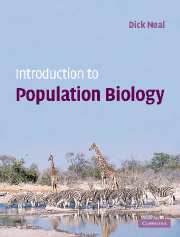Book contents
- Frontmatter
- Contents
- Preface
- Acknowledgements
- PART I Evolution by natural selection
- PART II Simple population growth models and their simulation
- PART III Population genetics and evolution
- PART IV Demography
- PART V Interactions between species, and the behaviour of individuals
- Glossary
- Solutions to problems
- References
- Index
PART IV - Demography
- Frontmatter
- Contents
- Preface
- Acknowledgements
- PART I Evolution by natural selection
- PART II Simple population growth models and their simulation
- PART III Population genetics and evolution
- PART IV Demography
- PART V Interactions between species, and the behaviour of individuals
- Glossary
- Solutions to problems
- References
- Index
Summary
In Chapters 4 and 5, we examined different models of population growth where the structure of the population, in terms of age or size, was constant or unimportant and so could be ignored. However, we are well aware that such factors as sex and age have profound effects on the chances of an individual dying, or producing offspring, and so we need to incorporate some of these factors into our growth models. These vital statistics of populations are called demographics, and the study of these statistics is called demography.
First, the pattern of mortality in relation to age is examined and quantified in Chapter 14. These age-specific death rates are combined with the age-specific birth rates in the following chapter to calculate the exponential growth rates of populations. Some populations with more complex growth characteristics cannot be modelled by the basic equations, and so matrix models of population growth are also introduced because they can be used to describe the growth of any population. Finally, Chapter 16 considers how the pattern of age-specific birth and death rates might have evolved by natural selection, followed by a brief review of the evolution of life-history traits of organisms.
- Type
- Chapter
- Information
- Introduction to Population Biology , pp. 215 - 216Publisher: Cambridge University PressPrint publication year: 2003



